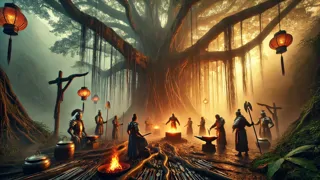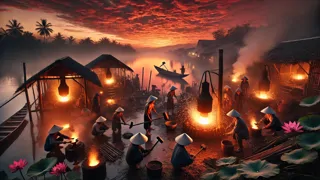Introduction
Under the ashen sky of the Red River Delta, where lotus blooms float on jade waters and the scent of damp earth mingles with drifting incense, the clang of hammers resonates like defiance itself. For generations, the Khmer forges of ancient L?c Vi?t lie silent at dawn—but now, an anguished prayer rises from hidden workshops, where artisans whisper ancient verses while stoking emerald flames with rice husk and sandalwood. They speak of the Aztec pantheon, gods who arrived on sickly winds from a distant, sun-bleached empire across the sea, demanding tribute of gold, maize, and human blood. Each furnace bears the imprint of that dark covenant: idols cast in cursed bronze, talismans forged to bind villages under Quetzalcoatl’s merciless decree. Yet within these smoldering heartlands, a new spark takes hold. Carried by mountain tribes through mist-shrouded passes and secret river channels, the promise of liberation grows in fervent hearts. Blacksmiths, once forced into servitude, now plot in moonlit sanctuaries, melding Vietnamese iron with obsidian shards gleaned from Mekong banks. Warriors in lacquered armor from the Tây Son hills forge alliances with fishermen from H? Long Bay, their voices raised in a single litany: freedom by steel, hope by flame. In every rivulet of molten metal, they see the shape of a future unchained. This is their prayer—a hymn of persistence echoing through shafts of sweat and molten gold—a rebellion born in forges and nurtured in the hum of furnaces.
Echoes of Tyranny in the Mekong Forgefires
In the jade-laced lowlands of the Mekong Delta, the forgefires of B?n Tre burn with an eerie glow that illuminates both the sky and the despair of its people. When the Aztec gods first arrived on great war canoes, they claimed the fertile fields as tribute, demanding parcels of sun-ripened rice, golden idols carved in the likeness of Quetzalcoatl, and the lifeblood of villagers in brutal sacrifices. Their shrines, built from teak and obsidian, towered above the rice paddies like dark sentinels. Beneath those altars, the forges once used to craft ceremonial gongs were repurposed into furnaces of subjugation. Slaves to the pantheon, local smiths were bound by oath tablets etched in Nahuatl and ch? Nôm, their souls weighed against the burning coals each morning. The oppressive clang of hammer on iron became a metronome of suffering—six hundred strikes for each god, one for every year of their reign over this new land.

Yet in secret by moonlight, a green rebellion took root within those same forges. Ph?m L? Anh, a young artisan whose family had tended the blacksmith’s hearth for generations, discovered a lost verse in her grandmother’s scroll—a prayer calling upon Bà Chúa X?, the Lady of the Realm, to kindle a hidden spark in mortal hearts. Under her breath, she chanted in Vietnamese, mixing her words with snippets of Nahuatl to honor both her ancestors and the land’s captors. Each whispered line stoked the furnaces with fresh purpose. She added scraps of red lacquer—an homage to the rising sun—forged into the molten iron, transforming it into shards that glowed with ethereal light. From the banks of the Mekong, fishermen ferried obsidian blades to her forge. Their nets, woven from palm fibers, concealed the fragments beneath bales of saltfish. In return, she tempered their anchors with runes of warding, shielding their vessels from divine augury and allowing news of rebellion to slip past Aztec priests like a swift river current.
Word traveled along the waterways to the floating markets of C?n Tho, where traders whispered of lantern-lit ships smuggling ironclad insurgents toward the temple ramparts of Sa Ðéc. There, the crimson spires of the Aztec shrines gleamed at dawn like blood-rubied thorns. Smiths and sailors, rice farmers and river nomads united under the banner of molten defiance. Their prayers, once directed at distant pyramids, now echoed within bamboo halls and earthen kilns, each invocation a promise that the day would come when the clang of liberated steel would drown out the cries of sacrificial horns.
Alliances Forged in Mountain and Delta
Beyond the delta’s fertile plains, where limestone karsts pierce the horizon like silent guardians, word of the Mekong insurrection reached the mountain clans of Tây Giang. Here, among terraced hills carpeted with tea and pepper, lived the H’Mông and Gi? Triêng peoples—warriors renowned for their stealth and resolve. Their sacred groves, draped in silk ribbons and talismanic feathers, had long stood apart from lowland politics. But when the Aztec priests demanded a portion of every mountain harvest—mountain maize, distilled ru?u from fermented persimmons, and even the crystal-known symbols carved from jade—they turned their spears south.

At the heart of this alliance stood Tr?n Minh Châu, a former naval commander now turned emissary, his naval pith helmet swapped for a lacquered helm etched with dragon motifs. He carried news of Ph?m L? Anh’s forges, and with him came three breastplates imbued with Mekong-iron and obsidian shards—symbols of unity. By lantern light in an ancient forest temple, he spoke of the pantheon’s tyranny and the hidden forges that tempered hope from molten despair. Beneath centuries-old banyan roots, elders of each clan tested the metal’s strength, its touch humming with latent magic. When they forged swords and pikes from that alloy, the weapons responded to their bearers as if alive—glowing faintly with embers of devotion.
Meanwhile, from the salt flats of southern Tây Ninh to the misty pinnacles of Yên T?, artisan-priests labored in tandem. They embedded Sanskrit mantras alongside Vietnamese incantations into every blade and arrowhead, forging an interwoven tapestry of belief capable of repelling divine chimeras. Boatwrights in H?i An carved long cuirassiers with hulls reinforced by iron scales, each inscribed with glyphs shielding against windstorms—once the domain of Tezcatlipoca’s whims. Even the elusive scribes from the imperial outpost of Thanh Hóa smuggled scrolls of Sun Yi, an ancient Chinese metallurgist whose treatise described the forging of “dragon heart steel,” said to glow with righteous fire when wielded by the pure of heart.
As dawn broke over the mountain passes, a caravan of fifty lantern-lit junks slipped silently down the Gia Long tributary, carrying a thousand warriors clad in midnight-black armor laced with molten veins. Their weapons did not just reflect the morning light—they refracted it, scattering fractals of color across bamboo walls, announcing the day when the Aztec gods themselves would feel the burn of mortal defiance.
The Final Conflagration at the Obsidian Shrine
At the heart of Ð?ng Nai’s emerald expanse stood the Obsidian Shrine—a black pyramid of smoked glass where the pantheon convened each solstice to renew their dominion. Its entrance, flanked by jaguar statues dripping with sacrificial blood, opened into a titanic hall ringed with braziers of eternal flame. Here, the gods spoke through priests clad in feathered headdresses, their tongues twisting ancient Nahuatl verses. Under their gaze, captives were laid upon stone altars while gold plates clattered like thunder when cast into the fire.

On the eve of the winter solstice, as the moon eclipsed the sun in an omen of upheaval, the allied forces arrived. From north to south, forges blazed in unison. The Mekong flotilla circled the shrine’s reflective moat, throwing lantern-light upon the obsidian walls. H’Mông archers climbed trees ringing the courtyard, firing arrows tipped with dragon-heart steel that shimmered like pulsing embers in flight. At the central gates, a phalanx of lacquered cuirassiers advanced, their shields bearing the stylized lotus of Vi?t and the coiling feathered serpent of the Aztec pantheon—a sign that this battle would determine the fate of both worlds.
Ph?m L? Anh and Tr?n Minh Châu led the vanguard. She carried the hammer that had forged their rebellion, its head inscribed with verses from Bà Chúa X?’s lost hymn. Each strike against the shrine’s doors unleashed ripples of light that cracked the obsidian into fractal patterns. From within, the priests unleashed divine retribution—columns of wind that shredded sails, spectral jaguars that lunged through shadows. But when Minh Châu raised his blade high, its tip blazed like a newborn star, banishing the phantoms with a chorus of steel on steel. The shrine quaked. Pillars collapsed, revealing an inner sanctum awash in molten gold, where Quetzalcoatl’s platinum mask lay on an altar of sacrilege.
With a final, earth-shattering blow, the hammer shattered the altar and sent shards of gold streaming like meteors through the ruined hall. The mask cracked, its divine visage falling into two halves as the ground trembled. The radiant heat of the forges washed over the shrine, melting the obsidian walls into molten glass that rained down in translucent tears. As dawn’s first light pierced the smoke, villagers walked into the courtyard, barefoot among the wreckage, and offered prayers of gratitude. The gods’ tyranny had fallen, their voices silenced by the very flames they once commanded.
In the stillness that followed, the once-distant stars seemed to shine brighter, as if the heavens themselves rejoiced at a world reborn.
Conclusion
When the dust settled and the embers cooled, the people of Vietnam awoke to a world unshackled from divine oppression. Forges once dedicated to idol-making now rang with joyous hammers, crafting plowshares and lanterns instead of altars and sacrificial urns. Across rice paddies and bamboo groves, the union of forges and furnaces became a symbol of communal renewal. Monks inscribed verses of unity on temple doors, blending Nahuatl glyphs with Vietnamese calligraphy, as a reminder that even the gods could be humbled by mortal perseverance. The Mekong River resumed its gentle flow, carrying seeds of rice and stories of bravery to distant delta villages. Mountain clans returned home to harvest tea and pepper in peace, their once-hidden sanctuaries open to travelers bearing gifts and tales alike. And in the courts of Hue, scholars recorded the epic in gold leaf and lacquered scrolls: an enduring chronicle of how hope found form in molten iron, how unity forged miracles in the furnace of resistance, and how a single prayer, whispered beside an ember, can ignite the courage to overthrow an empire.


















